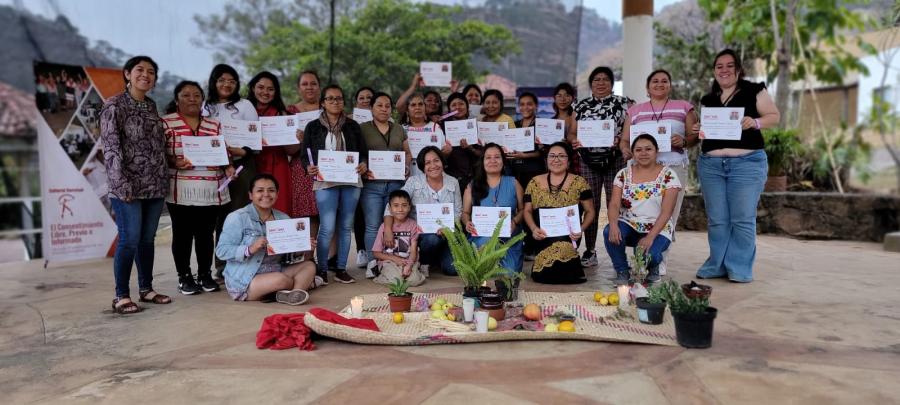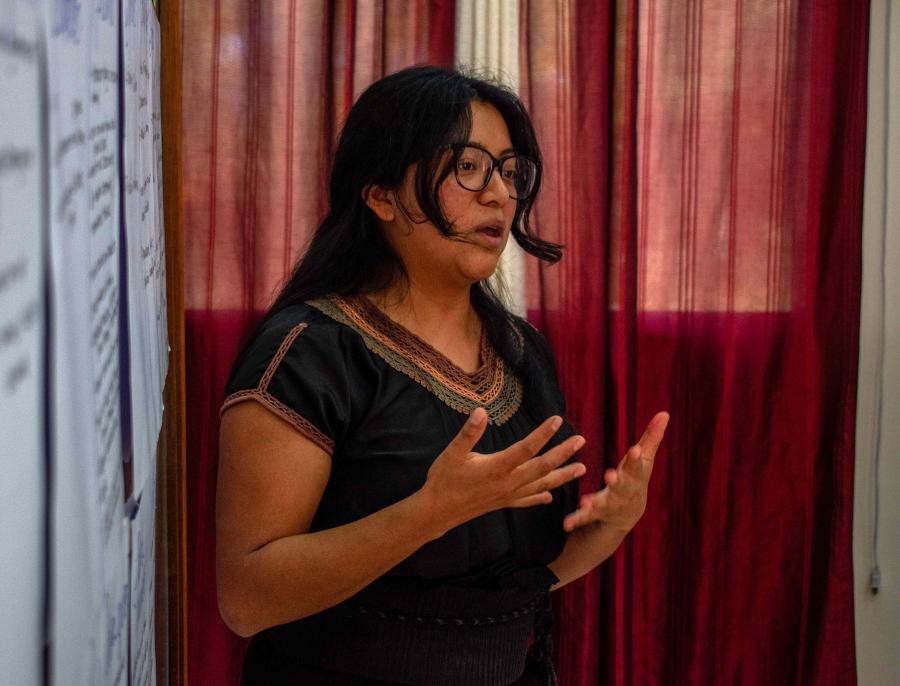Unless major changes in land use occur in southern Mexico, neither reserves nor rural communities will survive.
The state of Chiapas in southern Mexico contains an extraordinarily rich biological legacy and is home to a large and growing indigenous population. Accelerating rates of primary forest loss and ecological decline threaten the resource base and consequently the continued viability of the indigenous peoples. A small core of ecological reserves has been established, but the involvement of local, rural communities in conservation is essential to their success. However, unless major changes in land use occur, neither the reserves nor traditional rural communities have a chance of survival.
The proportion of Indians in Chiapas' population is one now very rare in the Americas. Two-thirds of the state's 2.5 million people live in rural areas (the reverse of the national ratio) and the majority of these are indigenous peoples. They include small numbers of coastal Zapotecs along the northern Pacific coast, Zoque villagers in the Grijalva Basin, and, principally, Mayan Indians of a number of language groups, including Tzeltal, Tzotzil, Tojolabal, Chol, Chontal and Lacondon. Mayans form the majority of the population in the Central and Eastern Highlands, and colonias (settlements of Indians) have migrated to all parts of the state, including the growing urban centers of San Cristobal de Las Casas, Tapachula and Comitan, and the state capital, Tuxtla Gutierrez. The Mayan population now also includes over 100,000 Guatemalan Indian refugees living in formal camps or scattered amongst the rural population in the east and south of the state.
To appreciate the impact of population displacement on the land, one must understand how uniquely intricate the state's ecosystems are. Chiapas consists of seven different physiographic regions, each containing distinct sets of vegetative associations. The largely mountainous state contains four highlands, of which two, the Northern and Central Highlands, are restricted to Chiapas, while the Eastern Highlands and the Sierra Madre extend south into Guatemala. The highlands are bounded by the Pacific and Gulf Coastal Plains; the great xeric Grijalva Basin isolates the Sierra Madre from the other highlands. In Chiapas, northern temperate flora and fauna meet the northernmost extension of the American tropical moist forest. Although in general the climate is moist, climate and associated vegetation vary markedly, from semi-desert to rainforest. Chiapas' two great river systems, the Grijalva and Usumacinta, together contain one-third of the fresh water in Mexico. That much of this water drains from northern Guatemala is one of the many ecological, political and cultural bonds between Chiapas and Guatemala that the international border straddles uneasily.
As a result of its geological and climatic diversity, and the intermingling of temperate and tropical gene pools, there evolved in Chiapas a particularly large and varied flora and fauna, characterized by a number of endemic (locally restricted) species (Breedlove). The high degree of endemism within Chiapas' ecosystems offers a complex germplasm heritage to potential use by humans. However, the evolutionary history and composition of Chiapas' primary forest communities are still not well understood. Even less well understood, unfortunately, are the species and mechanisms of the secondary, successional forests which have evolved to replace many of the primary forests (Gomez-Pompa).
The Mayans of present-day Chiapas are descended from peoples who drew upon primary and secondary forests for food, medicines, fuel and fibers. They created rich material cultures and lived in population densities unequalled until modern times. In clearings within primary and secondary forest, they developed many of the cultigens upon which human life now depends. Above all else, the Indians of Chiapas are children of these "people of corn."
Yet only a small part of Chiapas' indigenous population still lives by subsistence farming. The great majority of Indians are wage laborers in the agricultural labor force; and forest land is currently being cleared for cash cropping at such a rate as to obliterate the remaining primary forest lands of the state before the end of this century.
From the time of the Conquest, Chiapas has served as a source of unprocessed natural materials and agricultural commodities for regional and international export and has provided the cheap, expendable labor necessary for such extraction. Labor-intensive monocultural production of crops and pasturage has destroyed the forest ecology and has profoundly altered Indian culture and society.
Both expropriated Indian land and unsettled forest have been exploited and the commodities themselves have varied in response to political change and cycles of tropical monoculture. The main products have included cotton, cochineal and indigo dyes, cacao, sugar, wheat, rubber, coffee, bananas, other fruits and vegetables, pine, mahogany, other hardwoods, sheep and cattle. The means employed to secure the labor force have also varied: taxes, tribute duties, forced labor, debt peonage. Currently, demographic pressure is a force in recruitment. The majority of the rural population, Indian and non-Indian, does not now have access to enough land to survive by subsistence fanning. But the system of peonage and migrant labor is not new: a modern Chamula travels to the Sierra Madre to pick coffee at Rancho Berlin much as his ancestors walked to the same hills to harvest cacao nearly 400 years ago.
Indian resistance to the loss of their lands and to the expropriation of their labor has continued from the Conquest to the present. It has taken many forms: emigration to more inaccessible areas, legal petitions, agitation for return of lost lands, rebellion. Above all, that resistance has been expressed by a complex cultural inturning, through the creation of barrier institutions which encourage communal solidarity and lessen the impact of predation by outside forces on Indian lands and labor. The mechanisms of this resistance - expressed in elaborate ceremonial cycles and civil-religious hierarchies, distinctive costumes and artifacts - served, until very recently, to distinguish Indians from non-Indians (Hewitt de Alcantora).
Four centuries of resource extraction have degraded and imperiled the natural ecologies of Chiapas, enriched a very few people and left the bulk of the rural population the poorest of Mexico's poor. Indian and non-Indian alike are oppressed by poverty and "...ethnic differences in Chiapas are rapidly submerging beneath more substantial differences of wealth, property and power." (Wasserstrom).
There are campaigns on national and international levels to prevent the loss of Chiapas' remaining wildlands by bringing about changes in land use and the establishment of protected natural areas. Such areas presently include a national park, six ecological reserves administered by the state government and a federal biosphere reserve. Unfortunately, none of these reserves have yet successfully incorporated the rural population into their administration and defense.
Parque Nacional Lagunas de Montebello was the first conservation unit in Chiapas' history, established in 1956. It is a series of beautiful karst lakes set in 6,000 ha. of pine-oak-liquidambar forest. Administered as a tourist attraction, Montebello's flora have been protected, but the original wildlife population has collapsed. The park is now ringed by cleared forest and refugee settlements.
The state reserves have been managed quite differently. The director of the system is Don Miguel Alvarez del Toro, Mexico's pre-eminent zoologist. The state's emphasis has been on the protection of critical habitat for endangered wildlife, and consequently they have tried to minimize human presence within the reserves. The state petitioned the federal government to transfer control of federally-owned wildlands to the state, to be administered by the Institute de Historia Natural and the Consejo Protector de la Naturaleza. The first four reserves were dedicated in 1971, and the other two a decade later.
El Ocote contains 25,000 ha. of mid-montane rain forest in the Northern Highlands, with a rich faunal population, including harpy eagles and howler monkeys. However, as a stretch of the Grijalva River has been dammed for hydroelectric power and the reserve is now easily accessible by water, its fauna face increasing threats from hunting and spontaneous settlements.
Lagunas de Lacanja or Miramar contains forest and lakes, including Lacanja, the largest lake of the Eastern Highlands. The land was once populated solely by the southern Lacandon Maya. Non-Lacandon settlement and logging have threatened to degrade the pristine aquatic communities of the lakes.
Las Encruzijadas is 2,500 ha. of coastal mangrove swamp, islands and channels on the southern Pacific coast, home to what is possibly the largest jaguar population remaining in Chiapas. The federal and state government plan very large-scale agricultural development on the Coastal Plain, beginning with a flood control and drainage project financed by the World Bank. It is unclear what effect hydrological changes and increased local population might have on the reserve.
El Triunfo totals 30,000 ha. along the crest of the Sierra Madre. Its cloud forest summits shelter a rich bird population, including quetzals and the rare Homed Guan (Oreophasis derbianus). Wildlife is threatened by poaching and illegal land-clearing.
Los Bordos shelters rocky gorges on the upper reaches of Rio de la Venta and Rio Las Flores, home to a large raptor population.
Laguna Belgica reflects the state's focus on environmental education. It is a 42 ha. ecology park, which is toured by thousands of school children each year. It is a rural counterpart to Zoologico Regional Miguel Alvarez del Toro, one of he finest zoos in Latin America. It is devoted entirely to native Chiapas fauna, including reptiles and invertebrates.
All the state reserves are understaffed, under-budgeted and too small for the target fauna they seek to protect. They also lack mechanisms to involve local populations in their protection. A closer look at El Triunfo reveals their problems and potential. The cloud forest crest of the Sierra Madre is now a biological island: adjacent lower elevation forest on both flanks has been entirely given over to coffee plantations, secondary associations and fields. Illegal hunting for plumage and pelts is a growing problem (Mexico has thus far not signed the CITES accord prohibiting international trade in endangered species). However, the greater threat to the reserve is disturbance by local people trying to make a living as best they can, by clearing reserve land for crops or harvesting wild plants. In 1984, Chamula and Guatemalan laborers at a coffee finca on the reserve boundary were earning 350 pesos/day: miserable pay for difficult labor. But locals illegally working inside the reserve, cutting shale palm leaves (which they sell through a series of middlemen to florists in the US and Europe, for use as background greenery in floral displays) averaged 1,500 pesos/day, four times the wages on the coffee finca.
On the one hand, it is difficult to believe that the Institute can successfully prohibit intrusion of poor people into the reserve under these circumstances. On the other hand, shate palm cutters have a strong vested interest in seeing the forest preserved as their resource base. Intermediate-use zones surrounding the reserve could both protect critical fauna populations and provide income to the impoverished local community. The present reserve area, however, is too small for its resource base to be defended. The bleak economic prospects of Chiapas' rural population, Indian and non-Indian, puts the staff of the reserves in the odious position of choosing between wildlife and people, when both need to be defended.
The decline of the Lacandon forest in the Eastern Highlands further illustrates the interdependence of ecological stability and cultural survival in Chiapas. In 1977, some 330,000 ha. of the land was established as Reserva de la Biosfera Montes Azules. Its creation followed a year of intensive investigation by researchers from the Institute Nacional de Investigacciones sobre Recursos Bioticos (INIREB), Centro de Investigacciones Ecologicos del Suroeste (CIES), Centro de Ecodesarrollo (CECODES) and the Instituto de Biologia of the Universidad Nacional Autonimo de Mexico (UNAM). The entire Mexican scientific community was in agreement that the largest expanse of lowland tropical moist forest in Mexico was imperiled. However, the sexennial change of high government officials occurred (part of the peculiar revolutionary heritage of Mexico), and events took a different turn.
The biosphere reserve was declared, but it consolidated an earlier decision that forest-use rights to the land were vested in the three communities of Lacandon Maya. This decision denied land rights to the 50,000 Tzeltal and Chol-speaking colonists then living in the forest along with the Lacandon, who numbered less than 400. The Lacandon promptly signed timber contracts with two state-owned lumber companies, and the fate of the forest was sealed. The Lacandon have been bought off, and the colonists lost inducement to conserve a resource base they can be driven from at any moment. As the land was logged, new colonists arrived to settle on land opened up by logging roads. They have swollen the labor force which, by a complicated and destructive process, converts forest to cattle pasture.
The scale of forest conversion in the Eastern Highlands and in the rest of Chiapas is staggering. Chiapas' cattle population was estimated as 1,650,000 head in 1976, and 4,800,000 in 1982 - a 200 percent increase in six years. Thus the sad end of a forest that is, simultaneously, a forestry ejido, a cultural heritage site, a tourist attraction, a spreading treeless wasteland home to nearly 100,000 colonists and refugees, and a strategic military area. And, of course, a biosphere reserve.
Ironically, the key to ecologically-stable settlement in the Eastern Highlands already exists and has been ignored. The Lacandon developed a farming system based on a profound knowledge of the primary forest and the secondary successional pathways which regenerate it. By making small openings in the forest and cropping and intercropping carefully, they could harvest impressive yields of high quality foodstuffs while maintaining habitat and food for a large native fauna, which they hunted to provide additional food. Their extensive use of the resource base allowed stable, permanent occupation of a small area of forest (Nations and Nigh).
The Lacandon are abandoning their traditional agriculture, and the loss to the forest extends far beyond their villages. The knowledge of successional pathways which underlies their agriculture might hold the key to re-establishment of forest on land now being destroyed for short-term yields from logging and cattle. Their knowledge of wild edible plants and medicine sources might prove important to people far beyond Chiapas. Ethnobotanical knowledge, the legacy of centuries of ecological stability, is becoming as rare as quetzals, and like quetzals, deserves protection and preservation.
Protection of primary forest and native fauna, and their rich biotic and cultural potential, will require very difficult trade-offs of short-term resource harvest versus long-term ecological stability. There is no easy answer to the great tropical disorder that is Chiapas now: some areas might improve and many will undoubtedly decline. The future of Chiapas' Indians is in the balance in this mountainous land where, the people note, the shortest path between two points is often the most difficult and dangerous.
Article copyright Cultural Survival, Inc.



